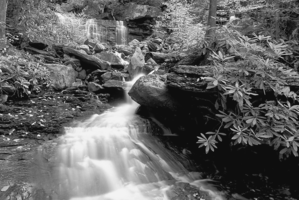 | Back to e-WV
| Back to e-WV
 The West Virginia Encyclopedia
The West Virginia Encyclopedia
 | Back to e-WV
| Back to e-WV
 The West Virginia Encyclopedia
The West Virginia Encyclopedia

West Virginia is blessed with an abundance of water. Within the state’s boundaries lie approximately 9,000 streams and rivers that total over 32,000 miles in length. In addition, there are approximately 100 public lakes and reservoirs that total over 22,000 surface acres. Over 100,000 acres of wetlands also are located within the state’s borders. West Virginia’s water resources are maintained by plentiful rainfall. Throughout the state rainfall averages nearly 40 inches per year, while in the higher elevations of the Allegheny Mountains, 55 inches or more per year are common.
In addition to abundant surface waters, West Virginia also possesses ample groundwater resources. The groundwater is stored within what scientists refer to as aquifers. These aquifers are water-bearing rock formations that may consist of sandstone, limestone, shale, or clay. Aquifers may be either deep or shallow.
Approximately a third of the state’s population gets its household water from groundwater sources, which include public and private wells and springs. The other two-thirds gets its water from surface water sources, which include streams, rivers, lakes, and ponds. In many rural parts of the state, public water systems don’t exist. In those areas, private wells or springs are used as a water source, although a small number of individuals may have a private water intake on a stream or lake.
The majority of industry in the state gets its water from surface sources.
However, groundwater is also used. Industries requiring large amounts of water typically locate along major rivers where water is abundant, but sometimes lakes are constructed as industrial water supplies. Mount Storm Lake in Grant County is one such lake, as is Cheat Lake in Monongalia County. Mount Storm Lake provides cooling and process water for the coal-fired Mount Storm Power Station, while Cheat Lake provides water for West Penn Power Company’s hydroelectric power plant near Morgantown.
Protecting the state’s water is largely the responsibility of the West Virginia Department of Environmental Protection. The DEP monitors the quality of the state’s rivers, streams, lakes, wetlands, and groundwater. In addition, the DEP is responsible for overseeing restoration of bodies of water that have been degraded by pollution.
Although West Virginia has long had regulations for the protection of water quality, historically there have been no provisions dealing with protection of water quantity. In 2004, the state legislature passed Senate Bill 163, the Water Resources Protection Act. The act, a product of compromise with industry interests wary of regulations, marked the first attempt by the state to gather information on quantity of water used by business and industry.
Water entered the realm of political debate as a growing scarcity of water in other regions reminded West Virginians of the value and vulnerability of the resource. The Water Resources Protection Act originated over concerns that water quantity may not be adequate to satisfy demand in areas of the state that are experiencing rapid population growth and development. Another concern is the potential for out-of-state users to lay claim to state waters. The legislature, in recognizing that water is a vital public resource, agreed that it is the state’s responsibility to claim and protect its waters for the use and benefit of its citizens.
The DEP is charged with overseeing implementation of the Water Resources Protection Act, which includes collecting information on: 1) location and quantity of surface and groundwater resources, 2) consumptive and non-consumptive withdrawals, 3) threats to beneficial uses, 4) growth areas where competition for water resources may be expected, and 5) any other information that may be beneficial to assessing water availability. Detailed information is sought from the state’s major water users, which are businesses and industries that use more than 750,000 gallons of water during any single month of a calendar year.
A study released in 2012 by the U.S. Geological Survey found that groundwater in West Virginia is of good quality, although levels of several compounds, including iron and manganese, exceeded recommended levels. The study examined water samples from more than 300 wells and springs in different regions of the state.
Written by Michael A. Arcuri
West Virginia DEP. Groundwater Programs and Activities: Biennial Report to the West Virginia Legislature. 2004.
West Virginia DEP. West Virginia's Water Quality Status Assessment Report. 2000.